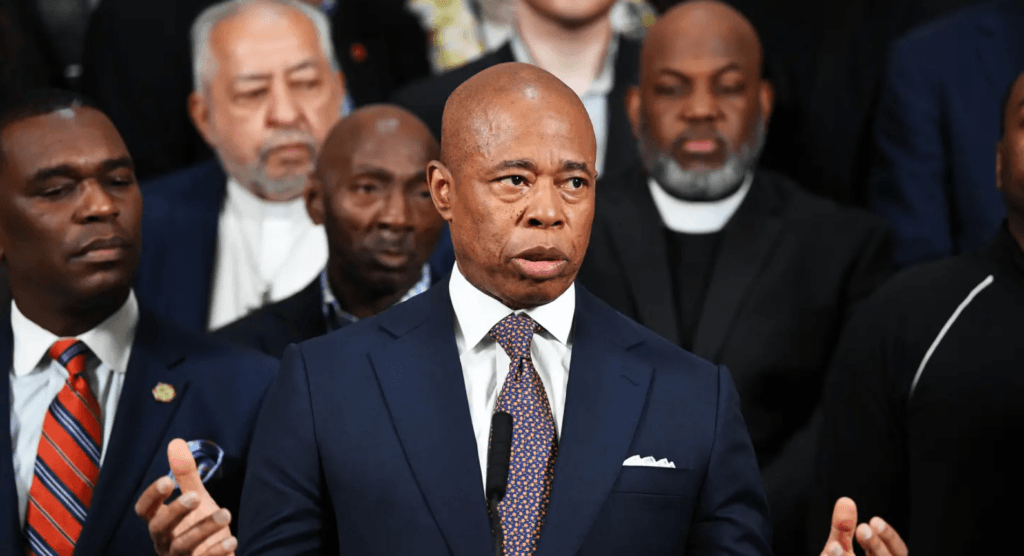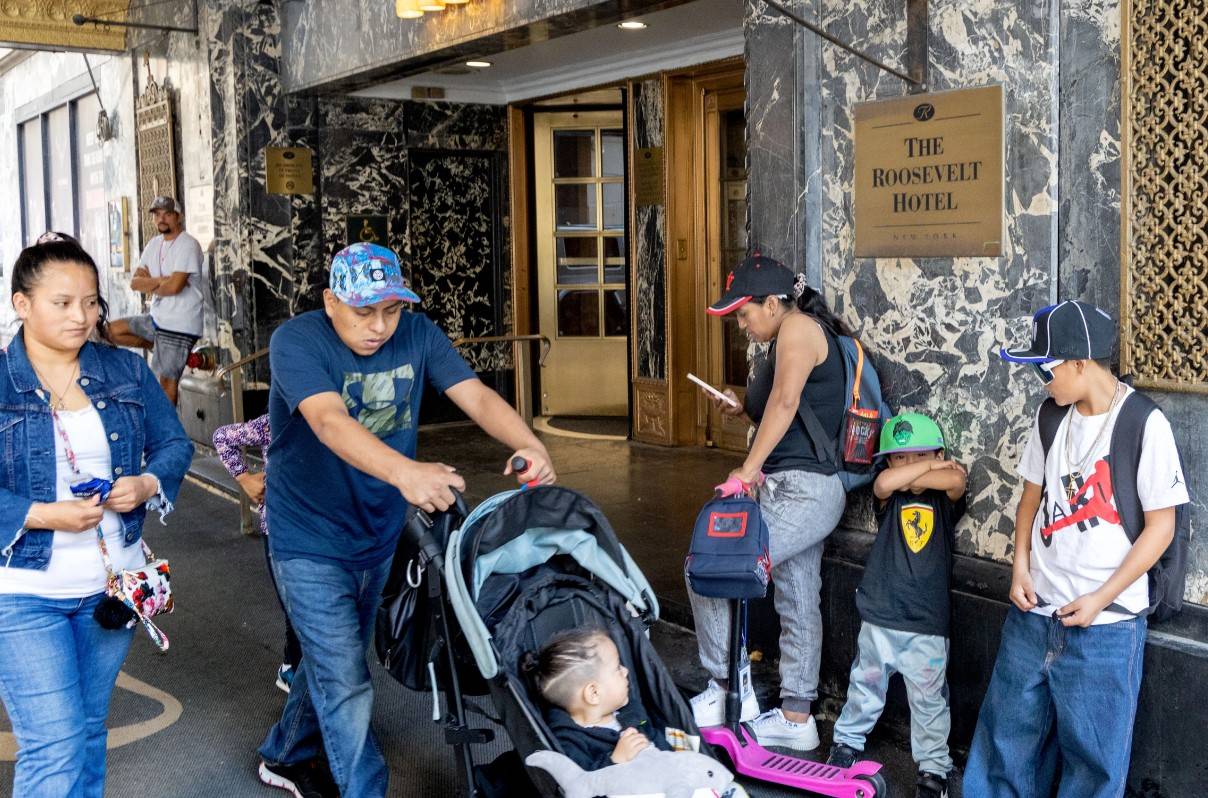
Eric Adams, New York Mayor, proposed a solution to the problem he created, having citizens house the illegal migrants in their private homes.
Mayor Eric Adams of New York City has proposed a unique solution to the ongoing migrant crisis plaguing the Big Apple. In an effort to address the lack of available beds for the increasing number of asylum seekers arriving in the city, Adams suggested a plan that would compensate local homeowners for sheltering migrants in their private residences.
The mayor unveiled the proposal during a recent announcement about housing adult male migrants in 50 different places of worship across the five boroughs. Adams argued that many residents were currently facing economic challenges and possessed spare rooms or additional living spaces that could be utilized for hosting migrants. By implementing the private residence plan, the mayor believed that taxpayers could benefit financially while simultaneously alleviating the strain on the city’s overcrowded shelter system.
Although specific details about the compensation for hosting migrants were not provided, Adams did mention that the city would pay places of worship approximately $125 per night for each asylum seeker they accommodated. This amount was significantly lower than the $380 cost incurred by the city when housing a migrant household, whether it included a family with children or single adults, in one of its shelter hotels.
Interestingly, if the private residence plan were to be implemented, homeowners could potentially receive more money for hosting a migrant than what foster parents in the state of New York received for raising a child. Currently, the state provides a daily allowance of $40 for children over 12 years old, as stated by the Office of Children and Family Services.
Adams emphasized the cost-effectiveness and potential benefits of the private residence plan, stating that assisting families directly was more economically viable than placing individuals in large congregate settings or emergency hotels. He also highlighted the advantage of bilingual family members being able to provide support to migrants who shared a common language.
However, the implementation of the plan would require overcoming the so-called “30-day rule.” Under existing New York law, a guest must reside in a dwelling for 30 consecutive days before they can legally become a tenant. City Hall acknowledged the need to navigate this rule and indicated a willingness to push for changes, both within the mayor’s jurisdiction and at the state level if necessary.
Not all homeowners welcomed the mayor’s proposal with open arms. Some criticized the plan as lacking sufficient details and expressed concerns about the potential consequences. Zainab Jah, a Park Slope resident, called the plan “nuts” and suggested that it could lead to chaos. Another homeowner, Tim Naylor, argued that while the idea might appeal to some homeowners, the city should not allocate funds to such initiatives when many New Yorkers were struggling to afford decent housing.
Tom Harriman, a retiree and condo owner in Park Slope, questioned the lack of specifics and referred to the plan as “strange.” He accused the mayor of focusing on sound bites without providing the necessary details. Joe Borelli, the NYC Council Republican leader, also expressed skepticism, raising questions about the goals, duration, and exit strategy of the proposed program.
The urgency for finding suitable accommodation for asylum seekers in New York City has become increasingly evident. The city is currently grappling with housing approximately 45,900 migrants across 157 emergency sites scattered throughout the five boroughs. In the past week alone, around 2,200 migrants sought shelter in city facilities, according to City Hall reports.
Criticism has been directed at the Adams administration regarding its handling of the crisis, including the use of elementary school gyms as temporary housing for migrants. To address the pressing need for additional housing, the mayor recently announced a faith-based plan in collaboration with the New York Disaster Interfaith Services. This two-year partnership aims to initially house around 1,000 migrants and establish five daytime centers to provide support during the day, allowing the faith-based spaces to continue serving the local community.
As Pastor Gil Monrose, the executive director of the Office
of Faith-Based and Community Partnerships, explained during the announcement, “Our city has witnessed an unprecedented influx of asylum seekers coming to New York City since last spring. I am really grateful that faith leaders are opening their doors to asylum seekers, providing their space as well as the hands of the community to care for them. New York is truly a city of faith.”
The proposed private residence plan put forth by Mayor Eric Adams reflects an innovative approach to tackling the ongoing migrant crisis in New York City. By incentivizing local homeowners to offer their spare rooms and living spaces to asylum seekers, Adams aims to ease the burden on the city’s overcrowded shelter system while providing financial relief to struggling residents.
“There are residents who are suffering right now because of economic challenges,” he said, according to a transcript of the event. “They have spare rooms. They have locales. And if we can find a way to get over the 30-day rule and other rules that government has in its place, we can take that $4.2 billion, $4.3 [billion] even maybe now, that we potentially would have to spend and we could put it back in the pockets of everyday New Yorkers, everyday houses of worship, instead of putting in the pockets of corporations and some of those corporations come from outside our city.”

The 30-day rule Adams referred to is a city law that requires a guest to be living in a residence for 30 days before they can legally become a tenant.
Adams’ vision involves compensating homeowners for their hospitality, although specific details regarding the amount of compensation remain undisclosed. The plan would also involve partnering with places of worship, which have agreed to house adult male migrants overnight at 50 different locations across the five boroughs. The mayor believes that by embracing this private residence proposal, not only can New Yorkers benefit economically, but they can also contribute to a more humane and personalized approach to accommodating migrants.
“It’s cheaper and it’s a good investment for us to go to a family and assist them instead of placing people in large congregate settings or in these emergency hotels,” Adams insisted of his private home plan.
Acknowledging the complexity of implementing such a plan, Adams highlighted the need to navigate existing regulations, including the “30-day rule” that prevents guests from immediately becoming tenants. City Hall is committed to exploring avenues for change, both within the mayor’s authority and by engaging with state colleagues to address necessary modifications at the legislative level.
While Adams’ private residence plan has drawn praise for its potential cost-effectiveness and utilization of existing resources, some homeowners have expressed reservations. Concerns have been raised about the lack of detailed information and the potential strain on local communities. Critics argue that with many New Yorkers already struggling to secure affordable housing, allocating funds for hosting migrants may not be the most prudent use of resources.
In response to skepticism, Adams reiterated the financial advantages of assisting families directly rather than relying on large congregate settings or emergency hotels. He emphasized the value of bilingual family members who can provide essential support to migrants who arrive with language barriers.
The urgency to find suitable accommodation for asylum seekers in New York City cannot be overstated. With approximately 45,900 migrants currently in need of shelter across 157 emergency sites, the strain on the city’s resources is evident. The recent faith-based plan, formed through a partnership with the New York Disaster Interfaith Services, offers a glimmer of hope. It not only provides temporary housing for migrants but also establishes daytime centers to offer support services and enables places of worship to continue their normal operations.
Mayor Adams’ multifaceted approach, combining the private residence plan with faith-based initiatives, demonstrates his commitment to finding creative solutions to the migrant crisis. By harnessing the generosity of homeowners and the compassion of religious communities, New York City aims to address the immediate needs of asylum seekers while fostering a sense of unity and shared responsibility.
As the plan moves forward, it is crucial that careful consideration be given to the concerns of homeowners and community members. Transparency and open communication will be vital in assuaging fears and ensuring that the implementation of the private residence plan aligns with the best interests of both migrants and the local population.
In the face of an unprecedented influx of asylum seekers, Mayor Eric Adams and his administration are taking bold steps to confront the challenges head-on. By fostering partnerships with faith-based organizations and proposing innovative solutions like the private residence plan, they are striving to create a more compassionate, efficient, and sustainable response to the migrant crisis in New York City.
